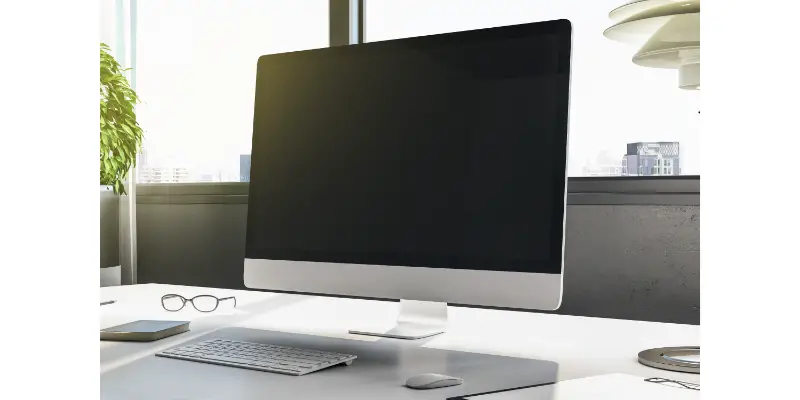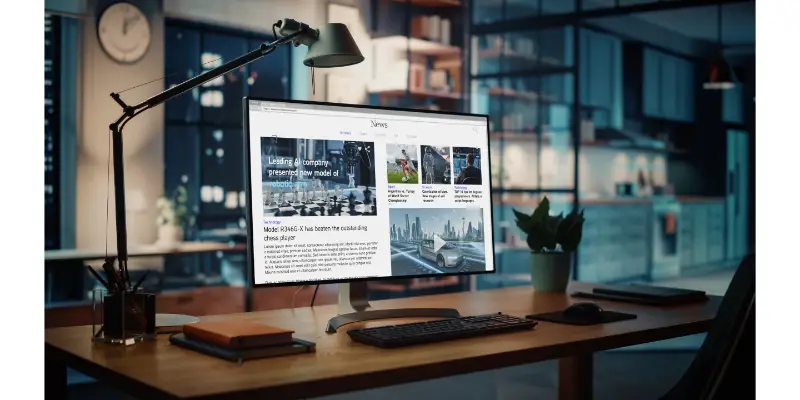Disclaimer: This post may contain affiliate links, meaning we get a small commission if you make a purchase through our links, at no cost to you. For more information, please visit our Disclaimer Page.
As humans living in the modern era of constant technological improvements, we have all necessarily became more tech-oriented than we used to be. Whether we have to purchase a PC for our office, home, or for travels, at some point, we have to make decisions about the machine we want to purchase. In today’s focus: All-in-One vs Desktop PC!
There are differences between AiO and PC machines, with AiO-s being more aesthetic, more sleek, mobile, and modern, whereas the main point on the side of PCs comes from easy customization and a level of future-proofing.
As with most such decisions, the final choice comes down mostly to personal preferences and intended use, so let’s dive a bit deeper into the differences between the function and purpose of AiO-s and PC-s!
Table of Contents
What are the Advantages and Disadvantages of All-in-One Computers?
First of all, what is an All-in-One computer exactly? These are machines that fulfill the function of PC-s, aka your standard computer, but with all the components and elements inside one body. The easier way to conceptualize this is that these are computers with all the hardware inside the monitor body. A halfway between computers and laptops or tablets.
With traditional PC-s, you would have a tower, within which either you or the company you are buying it from, will place specific disks, cards, chips, cables, etc. With AiO computers, all of these elements are built into one machine, which looks like a monitor, only somewhat thicker than traditional monitors, due to the extra space necessary for the components.
This design move brings with itself most of what AiO computers have as pros and cons, so let’s start with the first pro.
Pros
Easy to Move
One of the most important features of such devices is that they are very easy to relocate. Whether you are moving to a different home or just have to take your computer with you for any reason, it will be significantly easier to move an AiO than a standard PC.
All of us have probably lived through having to move a standard PC, which is a tedious process, seeing as you have to move all the cables, the monitor, the tower, keyboard, and mouse all separately, which makes for a frustrating job.
With AiO computers, this issue is solved, as this type of technology has everything (except the keyboard and mouse, naturally) inside one compact body, which makes it a lot easier to carry or move anywhere.
Aesthetic
Though modern PCs look incredible and sleek, there is a very modern and clean aesthetic to owning an AiO. It minimizes the number of cables you need and frees up all the space that a tower would take up, thus giving you a very professional and clean look.
This clean and aesthetic look might make AiO computers better options for offices that are otherwise cluttered, or any business, office, or bank where clients come and go and you just need an elegant and professional look.
Aside from the business and professional side, it can help declutter your room or space and give a more focused, minimalist look, which is a breath of fresh air for our eyes in today’s over-cluttered world.
Touchscreen Options
As AiO computers are a mix between PCs and tablets or laptops, and its main feature is a (usually large screen), to fit into the world of modern technological advancements, many of them come equipped with touchscreens.
This feature, aside from being very useful and fun, also allows for unique functions like precision drawing and painting, modeling, and more, which are either impossible or just harder to do on a standard mouse and keyboard setup.
Though you can have touchscreen monitors for PCs, they generally have to be paid for extra and cost a pretty penny for sure.
Incredibly User-Friendly
One of the other great things about AiO computers is their ease of setup and use. They work pretty similarly to tablets and laptops when it comes to setup. This means that you walk into a store, purchase an AiO, take it home, plug it in and just watch it boot and set up and you are ready to go.
Though PC setups aren’t very hard or complicated either, there are generally more issues surrounding that process, especially if you want to build your PC or install Windows or other OS for yourself.
One could say AiO-s are kind of “pre-packaged” and thus easier to start using.
Cons
Price
The first and probably most important drawback of AiOs comes in the form of price and costs. This is the most major issue, since not only are All-in-One computers usually substantially more expensive than PC-s with similar performance, the repair and maintenance costs are also worse, and that is for a couple of reasons.
The price, in and of itself is higher for an AiO than that of a PC with similar or same specs and performance, and that isn’t only the result of design and branding.
It is also because, in a PC tower, there is simply much more space to install all the various elements and parts, whereas it takes separate design and modeling for every specific AiO to get the placement and performance right.
Apart from this, just like buying a PC that has already been put together is more expensive than buying separate parts and building your PC, the fact that an AiO has everything installed and ready to go adds to the expense. Add to this the “luxury” of having an AiO in terms of design and you have yourself a pretty price tag.
Aside from the first amount of money you cash out at the store or online when ordering, there are other, not-so-hidden costs of owning an AiO, mostly in terms of maintenance, but it is better to cover that under the next drawback since these two are closely related:
Non-Customizable
The second con is probably the most frustrating and important one for the people out there who might call themselves geeky. AiO-s are more like tablets than anything else in that they aren’t all too customizable.
The thing is, for the design and the performance to work properly (and for more revenue, of course…), the companies cannot create machines that can be tinkered with as easily as you would with a PC.
If you don’t like the placement of the parts in your PC, you can most likely switch it up. You can add new parts, take out older ones and customize, even design them however you want.
Aside from specifically performance- or design-oriented customization which most often takes place at home for PCs, there is another major issue with this, which relates to the previous topic: maintenance prices.
If anything were to ever go wrong on your AiO, you can’t just buy a new piece and fit it in. If you tried to do that, you would very likely lose all guarantees if you had any in the first place.
Even if you were willing to do just that, it is often hard or impossible to change specific parts of specific All-in-One computers. Many parts are soldered down or built together, which in short means that you will probably need to take your AiO to an authorized and official repair station or distributor for fixing, maybe even after your warranty has expired.
This shoots maintenance costs and repair costs way above your standard PC. one of the worst things that can happen with an AiO for example, is when the monitor needs to be repaired or changed.
Aside from the astronomical fees you might be paying for the repair job itself, you will be without a computer for days to weeks, depending on the nature of the issue and the speed of service.
With a PC, you could either just buy a replacement monitor (which is likely to cost less than the repair of an AiO on its own), or buy a cheap substitute to use until your main monitor is being fixed, and the issue is solved.
Not Very Future-Proof
One of my personal biggest issues with AiO-s, as with most compact and non-customizable modern tech and gadgets, is the lack of future-proofing, or at least the decreased level of future-proofing when compared to a PC.
The thing is, even though development speeds in the tech speeds have slowed down recently, since making new improvements is increasingly difficult, the tech world is still improving at a fast and steady pace.
With 5G arriving, there will be a whole host of features that older machines will not be able to run or connect to. The IoT (Internet of Things) is also a project or vision that is in this category since it relies on a fast and secure internet connection between vast numbers of devices that can interact harmoniously.
Similar tech will not be available for gadgets and devices made 3 years ago.
The fact is that PC-s do not require that much future-proofing, exactly because they are customizable. They can be changed, certain elements can be swapped out, thus allowing for newer and newer functions and features at a relatively low cost.
With AiO-s, such improvement is much, much harder if not impossible. Constant software updates can keep the software at level for a while, but if the hardware gets too old, you can probably go ahead and buy a new AiO for a bunch of money, only to repeat the process in another couple of years.
What are the Advantages and Disadvantages of Desktop Computers?
PC-s are the tried and tested warriors of the tech era, being the first devices in the personal tech industry to make it mainstream, and they are still going strong.
In this section, I will discuss some of the pros and cons of these devices, to illustrate why they have been around for so long, and also what about them isn’t exactly perfect.
Pros
Low Costs
One of the major pros when it comes to using PC-s is the low cost it has compared to much of today’s gadget world. This low cost means that some things are sacrificed compared to some other gadgets on the market, but they might not be as important for the everyday user.
Also, with a little know-how, repairing a PC doesn’t have to cost any more than the price of a new part. The repair service fees can be completely neglected since anyone can learn how to build and repair a computer in a matter of days with today’s amount of information available online.
Customizability
As AiO-s lose a lot of points on this front, PC-s win a lot. PC-s are probably the number one most customizable tech devices on the market, seeing as you can switch out any single component and find another one that suits your purposes better for any given job or task.
A new game has just been released but your graphics card cannot run it properly? Just buy a newer graphics card while keeping all the other components of your PC, and you are good to go.
Perhaps you would like a newer, larger, curved monitor? You are about 3 clicks and some money away from getting just that, while not having spent a penny on the rest of your computer.
Also, when it comes to design, there are many DIY and many company-produced design variations that you can fit onto your PC build. The sky is the limit when it comes to both performance- and design-customization of a PC.
These two pros I discussed cover the entirety of what people love about PC-s so it is time to move on to some of the cons of this category.
Cons
Very Bad Mobility
Of course, the first point has to be about mobility. Technology in today’s world keeps on moving towards much more mobile, lightweight devices, and that is a category or expectation that PCs will never fulfill.
Moving a PC, even the most tediously packed PC, includes a lot of messed up cables, a lot of worrying about the tower not being damaged in any way, and more. Also, a PC isn’t something you will pick up and take over to your friend’s place to play unless you are looking to torture yourself.
Quite simply, the first place you placed a PC is the place it will spend most of its lifetime.
Takes Up Space
The major reason AiOs have risen in popularity, or at least one of the major reasons, is that they take up much less space than PC-s do. Specifically, probably less than half the space.
An AiO is literally near the size of your PC-s monitor, which is in itself a thin and aesthetic device, so it isn’t surprising many people would pick that over a cumbersome and large metal box full of tech next to a monitor similar in size to an actual AiO.
Not as User-Friendly
This point is not the most important one but can play an important role. This is because of the simple fact that if someone isn’t very tech-savvy, a full-blown PC isn’t probably the best option for them for everyday use.
PCs get their efficiency and benefits from being customizable, but if an individual doesn’t care to learn some basic PC maintenance and repair (which many people don’t nowadays), having a PC is just a fuss.
How do you Choose an All-in-One Computer?
Now let’s go through some main points to take into consideration when choosing an AiO for yourself. The following list is adjusted to your average user, not a pro gamer or perhaps a graphic designer because such roles require massively different equipment.
- Processor: look for AMD Ryzen 3 or Ryzen 5 processors for the best everyday use performance, but only choose Ryzen 3 if you don’t go beyond using Microsoft Office, movie watching, and web-browsing since you might run into some issues along the way. Intel Core i3 and i5 are also great options, with i5 also being the more powerful and thus more recommended one.
- Screen and display: Check whether you will require a touchscreen, because that might up the price, and stick with Windows machines if such a feature is something you need. A good screen refresh rate of 90 HZ is a great standard to shoot for, but 60 HZ is also great for everyday use. The size of the monitor depends on your preference, space, and intended activity.
- Graphics card: Any modern graphics card can handle everyday tasks, but if you need more power, look for AMD Radeon and Nvidia Geforce GPU-s.
- RAM: Look for 8 RAM and above for best lifespan and performance.
- Storage Space: A good 256 or 512 GB SSD card is good on its own, but look for a 1 TB HDD to accompany the SSD for optimal storage space.
- Design: Aside from aesthetics which is very personal, do check for adjustable screen height, not all AiOs have that feature and it can turn out to be hugely important if you spend long hours in front of the machine.
What Brands of All-in-One Computers are Best?
Though most people in the tech community do agree that you should always choose a device from a specs perspective, it helps to know some of the best brands out there for specific devices for a safer choice.
Here is a list of some of the best companies out there producing AiO computers, in no particular order:
- HP
- Microsoft
- Dell
- Apple
- Asus
- Acer
Which is Better: All-in-One or Desktop Computer?
Though a comparison between specific builds and devices would be more fruitful in determining a victor, one might as the question of which of these computers are overall better.
There is a pretty straightforward answer to this question, however, there are some conditions that have to be fulfilled for either side.
- If you like gaming or are a tech geek, or just need very high performance and do not need to move often, a PC will most likely be your best bet.
- If you care for aesthetics and want a more compact and mobile device that can perform everything a PC can, and also have some extra money to afford it, an AiO will surely be a better option for you.
Is it Worth Buying an All-in-One Computer?
So as a conclusion, after having compared two of the largest categories in the modern personal computer field, is it worth buying an AiO computer?
Though it comes down to personal taste at the end of the day, I believe it is worth buying an AiO for most everyday users, especially if costs aren’t their main concern. These machines help with decluttering, they look great, they are easy to move, and can perform much of the tasks (if not all) that a PC can, without being so bulky and taking up space.
This doesn’t mean PCs aren’t incredible to this day, but it does mean that if you are thinking of buying an AiO, there are some very compelling arguments to be made for the cause.




